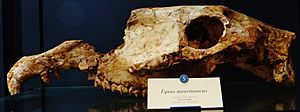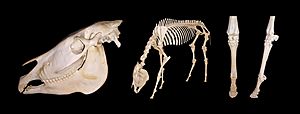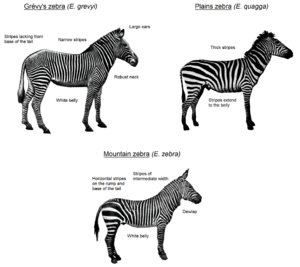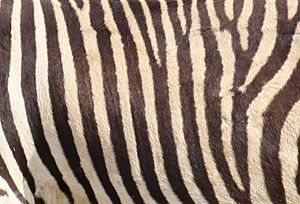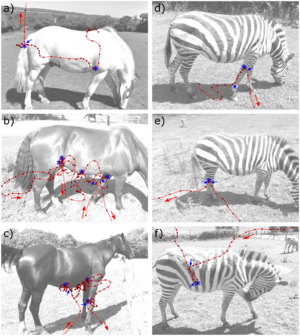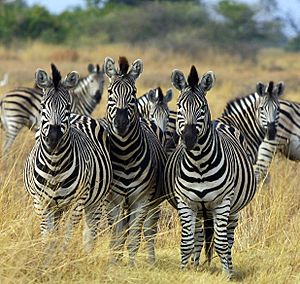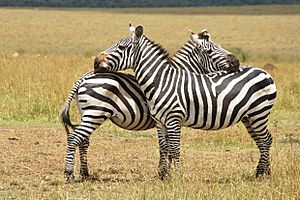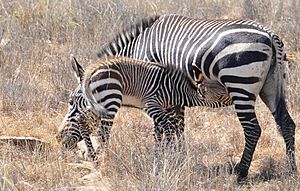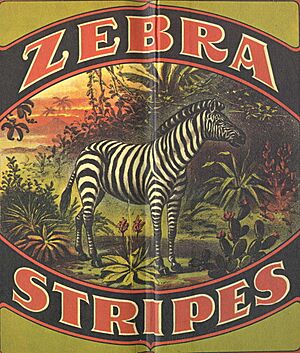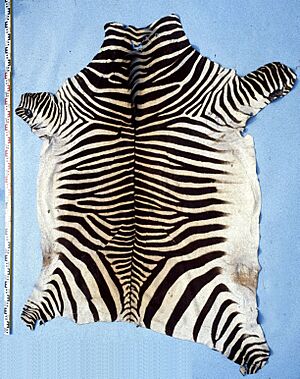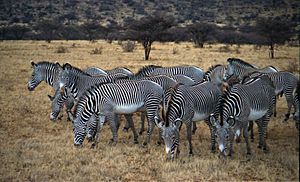Zebra facts for kids
Quick facts for kids Zebra |
|
|---|---|
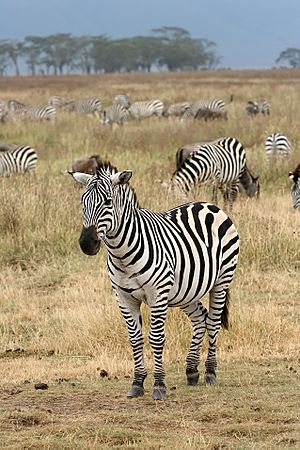 |
|
| A herd of plains zebras (Equus quagga) in the Ngorongoro Crater in Tanzania | |
| Scientific classification |
|
| Kingdom: | Animalia |
| Phylum: | Chordata |
| Class: | Mammalia |
| Order: | Perissodactyla |
| Family: | Equidae |
| Genus: | Equus |
| Subgenus: | Hippotigris C. H. Smith, 1841 |
| Species | |
|
†E. capensis |
|
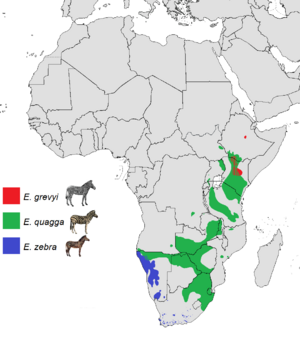 |
|
| Modern range of the three living zebra species | |
Zebras are amazing African animals. They are known for their unique black and white stripes. There are three main types of zebras alive today: the Grévy's zebra, the plains zebra, and the mountain zebra.
Zebras are related to horses and donkeys. All three belong to the same animal family, Equidae. Each zebra has a stripe pattern that is special, just like human fingerprints. Scientists think these stripes help keep biting flies away.
Zebras live in eastern and southern Africa. You can find them in many places, like savannahs, grasslands, woodlands, and mountains. They mainly eat grass and can live on plants that are not very high quality. Lions are their main predators. Zebras usually run away when there is danger. But they can also bite and kick to defend themselves.
Some zebra species live in family groups. These groups have one adult male, several adult females, and their young. Other zebras live alone or in loose groups. Zebras talk to each other using sounds, body language, and facial expressions. Grooming each other helps some zebras become better friends.
Zebras are very famous animals because of their stripes. People have shown them in art and stories for a long time. They were once popular pets for collectors. But unlike horses and donkeys, zebras have never been truly tamed.
Sadly, some zebra types are in danger. The Grévy's zebra is endangered, meaning there are very few left. The mountain zebra is vulnerable. The plains zebra is near-threatened. The quagga, a type of plains zebra, died out in the 1800s. But many zebras now live in protected areas.
Contents
What's in a Name?
The English word "zebra" comes from Italian, Spanish, or Portuguese. It might have come from the Latin word equiferus, which means "wild horse". Long ago, the ancient Greeks and Romans called the African zebra hippotigris, meaning "horse tiger".
Zebra Family Tree
Zebras are part of the Equus family. This family also includes horses and donkeys. These are the only living members of the Equidae family.
Scientists used to think Grévy's zebras were very different from plains and mountain zebras. But new studies show that all three zebra types are closely related. The quagga, which is now extinct, was once thought to be a separate species. But genetic tests show it was actually a type of plains zebra.
The Equus family first appeared in North America. Horses split off from zebras and donkeys about 4 to 4.5 million years ago. Zebras and donkeys then separated from each other around 2 million years ago. The mountain zebra became its own species about 1.6 million years ago. Plains and Grévy's zebras split about 1.4 million years ago.
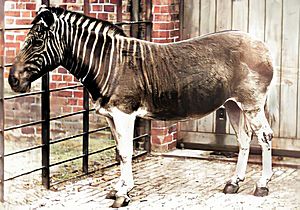
Zebra Species Alive Today
There are three living species of zebra. Each one has its own special features.
- Grévy's zebra (Equus grevyi): These are the largest zebras. They are about 2.5 to 3 meters (8 to 10 feet) long. They have thin, close stripes and a white belly. They live in eastern Africa.
- Plains zebra (Equus quagga): These zebras are about 2.1 to 2.4 meters (7 to 8 feet) long. They have thicker stripes that are horizontal on their back. Some have "shadow" stripes. They live in eastern and southern Africa.
- Mountain zebra (Equus zebra): These zebras are about 2.1 to 2.6 meters (7 to 8.5 feet) long. They have stripes that are in between the other two in width. They also have a dewlap (a fold of skin) under their neck. They live in southwestern Africa.
Zebra Relatives from the Past
Scientists have found fossils of zebras that lived long ago. Equus koobiforensis is an early zebra relative found in Ethiopia and Tanzania. It lived about 2.3 million years ago. Another ancient zebra, E. oldowayensis, lived 1.8 million years ago. The Cape zebra lived in southern and eastern Africa about 2 million years ago.
Zebra Mixes
Sometimes, different types of zebras can have babies together. Plains zebras and Grévy's zebras have had fertile young in the wild. Zebras have also been bred with horses and donkeys in zoos. These mixed animals are called zebroids.
- A zorse is a mix of a zebra and a horse.
- A zonkey is a mix of a zebra and a donkey.
- A zoni is a mix of a zebra and a pony.
Zebroids are often born unable to have their own babies. They can also be smaller than normal.
Zebra Features
Like all wild horses, zebras have strong bodies and long necks. They have a tufted tail and a stiff mane. Their thin legs end in hard hooves. Zebras have strong teeth for eating grass. Males have special teeth called canines, which they can use to fight.
Zebra eyes are on the sides of their head. This helps them see over tall grass while they eat. Their ears are long and can move. This helps them find where sounds are coming from.
Zebra Stripes
Zebras are famous for their black and white stripes. Their skin underneath is actually black. Baby zebras are born with brown and white stripes. These stripes get darker as they grow up. Each zebra's stripe pattern is unique.
Why Do Zebras Have Stripes?
Scientists have wondered about zebra stripes for a long time. Here are some ideas:
- Hiding from predators: Some thought stripes helped zebras blend in or break up their shape. But zebras live in open areas and don't try to hide. Lions and hyenas also don't seem to have trouble seeing them.
- Confusing predators: This idea says stripes make it hard for predators to pick out one zebra in a running group. It might also make it hard to guess their speed or direction. But lions still seem to catch zebras easily.
- Warning others: Some thought stripes were a warning sign to predators. But zebras are often hunted by lions, so the stripes don't seem to scare them away.
- Social reasons: Stripes might help zebras recognize each other. They could also be a sign of how healthy a zebra is. But there's no strong proof for this idea.
- Controlling body temperature: This idea suggests stripes help zebras stay cool. Black stripes absorb heat, and white stripes reflect it. This might create air currents that cool the zebra down. But studies have not found that zebras are cooler than other animals in their habitat.
- Keeping flies away: This is the most popular idea today. Biting flies, like horse flies, can spread diseases to zebras. Studies show that flies prefer to land on solid colors rather than stripes. Zebras also swat their tails to keep flies away.
Zebra Life and Habits
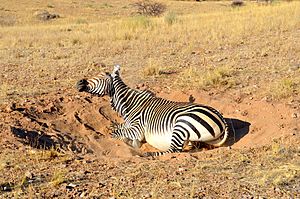
Zebras sometimes travel long distances to find water and food. Plains zebras have traveled up to 500 kilometers (310 miles) in Africa. They seem to remember where the best places to eat are. Plains zebras need more water than other types. They usually stay within 10 to 12 kilometers (6 to 7.5 miles) of a water source. Grévy's zebras can go almost a week without water. Mountain zebras can live in high places, up to 2,000 meters (6,500 feet) high.
Zebras sleep about seven hours a day. They often stand up when they sleep during the day. At night, they lie down. They like to roll on the ground and rub against things.
Zebras mostly eat grasses. But they will also eat bark, leaves, fruits, and roots if they need to. Zebras spend a lot of their time eating, sometimes 60-80% of their day. Plains zebras help other animals by eating the tall, less nutritious grass. This makes way for other grazers that like shorter, more nutritious grass.
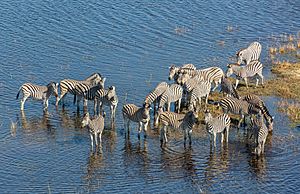
Lions are the main hunters of zebras. Leopards, cheetahs, and spotted hyenas also hunt them. Nile crocodiles can catch zebras near water. When a lion chases a zebra, the zebra runs fast and makes quick turns. Zebras can bite and kick to defend themselves. They are more aggressive with smaller predators like hyenas, especially when protecting their young.
How Zebras Live Together
Zebras have different ways of living in groups. Plains and mountain zebras live in stable family groups called harems. A harem has one male, several females, and their babies. These groups move around in their own areas. The male zebra protects his harem by bringing in young females. Females in harems can eat more and are safer from predators. The females have a pecking order, with older females being more in charge. When they travel, the most important females lead.
Grévy's zebras live in drier places. Adult males have large areas of land called territories. They mark their land with piles of poop. They mate with females who come into their territory. Females with babies often stay in territories near water. Staying in a territory keeps females safe from other males.
Young males who are not yet ready to have a family live in bachelor groups. These groups are usually young males. They practice fighting and greeting each other. This helps them get ready to lead their own harems later.
Males often fight over females. They bite and kick each other. If a male zebra is healthy, other males usually don't challenge him for his harem.
How Zebras Communicate
Zebras make many different sounds. Plains zebras make a barking sound, like "a-ha, a-ha". Grévy's zebras make a sound like a hippo's grunt mixed with a donkey's wheeze. Loud snorting means they are alarmed. Squealing can mean they are in pain or just being friendly.
Zebras also use their faces and bodies to communicate. They can make many different facial expressions. Dropping their ears back and whipping their tail can mean they are about to kick. Flattened ears, showing teeth, and waving their head can be threatening signs from male zebras.
Zebras greet each other by rubbing and sniffing. Then they might rub their cheeks or lay their heads on each other. This often happens between males in harems or bachelor groups. Plains and mountain zebras also groom each other. They nibble and scratch each other's necks, shoulders, and backs. Grooming helps them bond and reduces fighting.
Reproduction and Life Cycle
Usually, a female zebra gives birth to one baby, called a foal. The foal can run within an hour of being born! A newborn foal will follow anything that moves. So, new mothers keep other zebras away from their babies. This helps the foal learn its mother's stripes, smell, and voice.
Foals start eating grass when they are a few weeks old. But they will continue to drink their mother's milk for 8 to 13 months. Grévy's zebra foals drink water only after three months because they live in dry places.
Zebra mothers mostly care for their foals. But if dangerous animals like hyenas are nearby, the whole group works together. They form a protective circle with the foals in the middle. The male zebra will charge at predators that get too close. Grévy's zebra foals sometimes stay in "kindergartens" when their mothers go to find water. The male zebra in that area looks after them.
Zebras and Humans
Cultural Importance
Zebras are some of the most famous animals because of their stripes. People think they are beautiful and graceful. Zebras are popular in photos and children's stories. You often see them in alphabet books for the letter 'Z'. Zebra stripes are also used in fashion, furniture, and art.
Zebras have been important in African art and culture for thousands of years. They appear in ancient rock art in Southern Africa. African folk tales sometimes tell stories about how the zebra got its stripes. The Maasai people have a saying: "a man without culture is like a zebra without stripes." The San people linked zebra stripes to water, rain, and lightning.
For the Shona people, the zebra is a special animal. Its stripes stand for the joining of male and female. In Zimbabwe, zebra stripes decorate a special school where girls learn to become adults. The plains zebra is the national animal of Botswana. Zebras have been on stamps in Africa for many years.
Zebras have also appeared in art and stories outside of Africa. People sometimes see them as an exotic version of a horse. You might see zebras in movies like Racing Stripes, The Lion King, and the Madagascar films.
Artists love to paint zebras. Their black and white stripes are perfect for abstract and modern art.
Zebras in Zoos
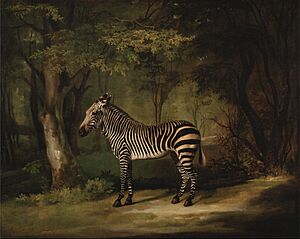
People have kept zebras in zoos for a very long time, even since the Roman Empire. Zebras were often sent as gifts between rulers. In 1261, the Sultan of Egypt sent a zebra to a king in Spain. In 1417, a zebra was given to the Chinese emperor.
In 1762, Queen Charlotte of Britain received a zebra as a wedding gift. Everyone in Britain was excited to see it at Buckingham Palace. This zebra became famous and was even painted by a famous artist. But it was also known for being a bit grumpy and kicking visitors! In 1882, a zebra was sent to the French president, Jules Grévy. The species was named after him.
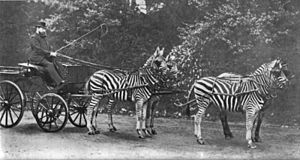
People have tried to tame zebras, but it has been very hard. Zebras have evolved to be aggressive because they live with many large predators in Africa. However, some zebras have been trained. In ancient Rome, zebras pulled chariots in games. In the late 1800s, a scientist named Walter Rothschild trained zebras to pull his carriage in England. He even drove them to Buckingham Palace! But he knew they were too small and aggressive to ride.
Zebra Conservation
Today, the IUCN Red List tracks how zebras are doing. The Grévy's zebra is endangered, with fewer than 2,000 adults left. The mountain zebra is vulnerable, but its numbers are growing. The plains zebra is near-threatened, and its population is decreasing.
Humans have caused problems for zebras. Their habitats are being destroyed, and their land is being cut up by fences. People also hunt zebras for their skin and meat. Zebras also have to compete with farm animals for food. Wars in some countries have also hurt zebra populations. In the past, zebra skins were used for rugs and chairs. Today, trophy hunters sometimes hunt zebras, and their skins can sell for a lot of money.
The quagga, a type of plains zebra, was hunted to extinction in the 1800s. The last wild quagga died in 1878. The last quagga in a zoo died in 1883. The Cape mountain zebra almost died out too, with fewer than 50 left in the 1950s. But thanks to protection efforts, their numbers have grown to over 2,600.
Many zebras now live in protected areas. Important places for Grévy's zebras include Yabelo Wildlife Sanctuary in Ethiopia and Samburu National Reserve in Kenya. Plains zebras live in Serengeti National Park in Tanzania and Kruger National Park in South Africa. Mountain zebras are protected in Mountain Zebra National Park in South Africa and Etosha National Park in Namibia.
See also
 In Spanish: Cebra para niños
In Spanish: Cebra para niños


